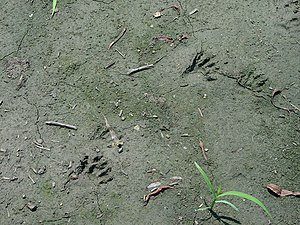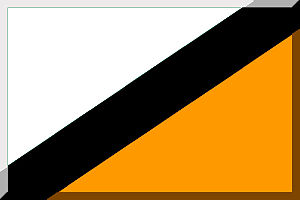Difference between revisions of "AY Honors/Animal Tracking/Answer Key"
(added raccoon) |
|||
| Line 6: | Line 6: | ||
{{TODO|make a track identification chart}} | {{TODO|make a track identification chart}} | ||
| + | |||
| + | {{Animal_sign | ||
| + | | latin_name = Procyon lotor | ||
| + | | common_name = Raccoon | ||
| + | | animal_image = Procyon lotor (Common raccoon).jpg | ||
| + | | track_image = Waschbaer fg01.jpg | ||
| + | | scat_image = scat.jpg | ||
| + | | description = A raccoon is a nocturnal mammal in the genus Procyon of the Procyonidae family. Raccoons are unusual for their thumbs, which – though not opposable – enable them to open many closed containers such as garbage cans and doors. They are intelligent omnivores with a reputation for being clever and mischievous. Raccoons range from 50 to 100 cm in length (including the tail) and weigh between 4.5 and 16 kg. The raccoon's tail ranges from 20 to 40 cm in length. Male raccoons are generally larger than females. | ||
| + | | range = North America | ||
| + | }} | ||
==2. Name at least three things that tracks tell us.== | ==2. Name at least three things that tracks tell us.== | ||
Revision as of 18:42, 15 January 2007
1. Know ten kinds of tracks, including two kinds of bird tracks. Make plaster casts of five.
To do this, you will need to bring dry plaster of Paris, water, a mixing container, a mixing stick (a paint stirrer will do nicely), and something to make rings out of. Plaster of Paris can be bought either dry, or ready-mixed. It is probably better to get the dry type so that you can mix it on site. It will need to be soupy to make a detailed cast. When you find a suitable track, place a ring around it. The ring can be made from almost anything - a tin can with the bottom cut out, a paper cup with the bottom removed, a strip of poster board 1 inch (2.5 cm) wide and taped together at the ends to form a circle, etc. Make sure the ring is larger than the track. You can also make the cast without a ring, but it is much better if you use one. Once the ring is in place, mix just enough plaster and water to fill the ring up to one inch (2.5 cm) deep. It sets quickly, so you will not want to mix up too much at a time. Mix water with the dry plaster and stir it until it is smooth. It should be about the same consitency as pancake batter or apple sauce. Pour it into the ring. Once this is done, you can set out in search of more tracks, or you can wait until the plaster sets. If you set out for more, be sure to come back to collect your cast.
One good way to complete this requirement is by heading to a river right after flooding has receded. There will likely be plenty of easily identifiable kinds of tracks, and the smooth mud makes for excellent casting.
Raccoon (Procyon lotor)
Usage:
- {{Animal sign
- | all the parameters ...
- }}
Example: Template loop detected: Template:Animal sign </noinclude>
2. Name at least three things that tracks tell us.
Animal tracks can tell us many things about the animal that made them, including:
- The species
- Its direction of travel
- How fast it was going
- How large it was
- How long ago the animal made the tracks.
- Sometimes tracks can tell the gender of the animal
- Sometimes tracks can tell us the animal's age.
3. Trail some animal tracks, identify the animal if possible, and tell whether it was running or walking. Measure between the tracks of one animal when running and walking.
4. Maintain a tracking station for at least three days by doing the following:
a. Select a flat open space in some quiet place near your camp or home.
Do not select a space too close to your campsite, because you do not want to attract them into your camp. Animals need water, so a really good place to select is around a source of fresh water. River banks, stream banks, near ponds, and the shores of lakes are all good places to fin animal tracks. However, the place you select must be quiet. Avoid places that are frequented by people.
b. Smooth out ground, mud, sand, etc.
There may already be some tracks in the area, but you are interested in fresh tracks. Smoothing the ground erases them and allows for fresh prints.
c. Place food out for wildlife.
Another option is to use a salt or mineral block. The type of food you place will affect the type of animals you attract, as will the season. If there is plenty of food available without your "bait," the animals will be suspicious and stay away. However, if they are hungry (as in winter) or if the food you select is irresistable, they will be more likely to come. Sliced apples out of season will attract many types of animals.
d. Check each day for tracks and replenish food when necessary.
When camping, remember to store your food in a place where the animals cannot get to it. Seal it tightly and place it out of the reach of raccoons and bears (both of which are very clever at getting food). Under no circumstances should you store food in a tent - especially in one that people will be sleeping in. A tent is no barrier to a hungry skunk. The morning is the best time to check for tracks. Most forest creatures are nocturnal, so in the morning the tracks will be freshest. Also, human visitors are less likely to trample the tracks before you get a chance to observe and if necessary, cast them.
5. Name two animals for each tracking group.
a. Flatfoots
b. Toe walkers
c. Toenail walkers
d. Bounders or long hindleggers
6. Name four signs of the presence of mammals.
Animals leave many indications that they were present. These are collectively called sign. Sign includes:
- Tracks
- Not only footprints, but marks left on the ground by the tail or by other body parts (think snakes).
- Scat
- Scat is another word for animal droppings or manure.
- Fur, skin, feathers, and antlers
- Animals may leave bits of fur behind if it gets caught in a tree's bark, or in thorns. Snakes and other reptiles shed their skin and leave it behind. Birds drop feathers and in the fall deer drop antlers.
- Cuttings
- Cuttings are things such as acorn shells which have been nibbled on. Deer and squirrel often leave them behind.
- Scratches on trees
- Bears, members of the cat family, and other predators will sharpen their claws on tree trunks. Sometimes they will do this to mark their territory.
- Scent Posts
- Many animals mark their territory by urinating on trees or other prominent items. If you are walking through the woods and smell a strong musky odor, look around — you may find other sign.
- Carcasses
- Once a predator has had its fill of a kill, it will leave the carcass. Some animals will guard their carcasses though so they can feed on them again after they've digested some of the previous meal, so be careful if you find one.



